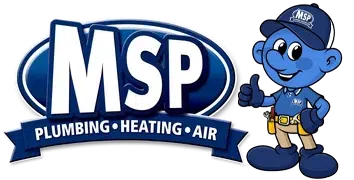Cold temps and high winds resulting in a low wind chill is the major cause of frozen pipes in the wall. The second leading cause is homes not being occupied and losing heat.
Frozen plumbing can be more than a temporary inconvenience. Frozen pipes can cause major damage when the pipe thaws and the water starts to flow. Frozen hot water heat lines will prevent heat from reaching parts of your home. Water damage can result when a split water pipe occurs due to expansion caused by freezing. Thawing a pipe as soon as possible can help prevent a break in a pipe.
Below are a few steps that you can take to prevent frozen plumbing.
- Let a faucet drip that has a supply pipe running along an outside wall. You do not need a strong flow, just enough to keep the water flowing. Flowing water freezes slower than standing water in a pipe.
- Do not turn your heat down during windy cold days. The cooling down period allows the cold to penetrate walls before it comes into your house. The pipes are exposed to this cold air. Hot water heat is more prone to freezing due to the hot water in the heating lines. Hot water will freeze faster than cold or room temperature water.
- Leave cabinet doors under sinks that face outside walls open. These areas are not generally heated but do receive the cold air coming in through walls. This will help prevent froze water supply and waste piping.
- Insulate walls where piping runs. Opening walls and checking is not always practical. However checking for insulation when walls are open for repairs or remodeling is a great idea.
- Keep garage doors closed when not going in or out. The cold air will freeze pipes exposed to garage walls. These walls are not always insulated as well as outside walls.
- Shut off water to outside faucets. Leaking outside faucets and piping to them are caused by freezing over the winter. We replace many outside faucets and piping in the spring due to freezing.
- Have a neighbor, relative or friend check on your house when you go out of town. Total house freeze ups that require major repair result from homes that the heat goes out and the house gets down below 32 degrees. All the plumbing freezes including toilets, faucets etc. This could amount to costs well over $10,000.00.
Once your plumbing is frozen you have some options:
- Expose the pipe and put a space heater by it. This works when you know where the frozen pipe is. Under sink frozen pipes can be thawed this way. Leave the faucet on so the water can flow when it starts unfreezing.
- Heat up the room where the frozen pipe is. You can use a space heater to heat up a room if it is not too large. Heating up the room will eventually heat up the pipe. This is not a guarantee and may take a long time.
- Call a plumber. Plumbers carry equipment that will electrically charge the pipe to warm it up to thaw the pipe. It is recommended that you have a professional do this as there is possibility of damage if not done correctly.
What you do not want to do:
- Ignore it. Your pipe will not thaw by ignoring it. It will either freeze more and then burst or stay frozen until the temperature outside warms well above freezing.
- Use a blowtorch. This can cause the water to heat up too fast in the pipe and cause it to expand thus breaking the pipe. There is also the danger of starting a fire causing more damage than the frozen pipe would cause.
